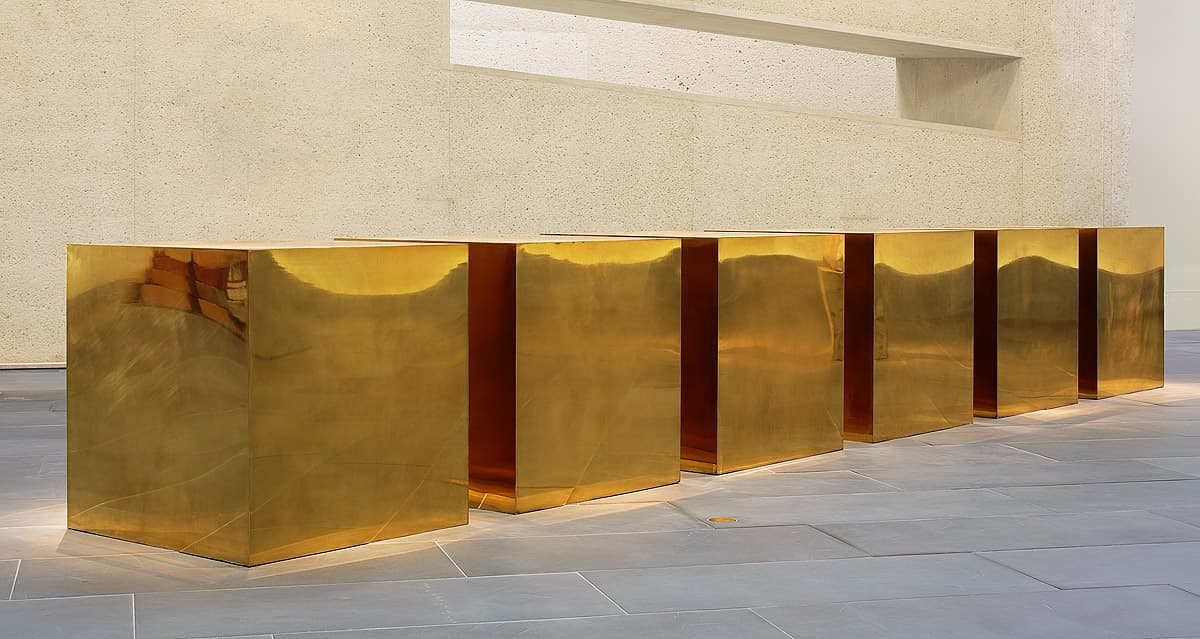

Donald Judd
Learn moreUntitled 1974
© Donald Judd. VAGA/Copyright Agency Purchased 1975
More detail | PermalinkDonald Judd’s sculpture Untitled 1974 comprises six box units of highly-polished brass, fabricated to the artist’s specifications by Berstein Brothers in Long Island City, New York. The box is one of Judd’s most used forms, either closed, semi-hollow or transparent. His first ‘stack’ dates from 1965 but he continued to develop this form throughout his career. Vertically, the stacks usually consist of 10 units, alternating solids and voids of equal size, attached to the wall in a precisely-ordered configuration; fewer are used if the given space has a low ceiling. When free-standing, Judd intended his boxes to be placed directly on the ground, refuting the base or plinth of traditional sculpture. Whether mounted in a vertical or horizontal progression of uniform visual rhythms, or placed in a straight line across a surface, his boxes present as neutral while making subtle reference to their surrounds.
Judd’s works embody seriality, either as repetition of a standard unit or a simple mathematical progression. Developing his style in New York in the 1950s and 60s, he overcame a conflict between two- and three-dimensional form by including relief objects in painting, and it was these early experiments that encouraged the evolution of his box sculptures. Judd credited this development in his work to Jackson Pollock, who realised the element of the self-contained unit in different manifestations. Polarisation emerges from the conjunction of two dissimilar materials or colours, the opulence of the polished surface and the extreme restraint of the form, the enclosed volume and open interiors or the negative space between objects. The formality of Judd’s ‘specific objects’ reduces the viewer to accepting the pieces as units in which measurements and even rhythms, as well as surface, are the instruments of his language.[1] In Untitled the large size of the boxes is as important as their number and spacing.
Like so many of his generation, Judd ignored traditional craft skills in deference to an overriding system or idea. In order to obtain a perfect finish without having to rework the material, he had his works made in a factory. His favoured metals were painted steel, aluminium or galvanised iron, sometimes in combination with another industrial material, perspex. Subsequently he used unpolished laminated wood and, for his outdoor sculptures, concrete. In all his work Judd exploits the properties of his materials: the effect of the brass in Untitled is to reflect and project the setting into which the sculpture has been placed. In isolation, the six boxes merge into the floor space of a gallery; surrounded by people, the sculpture becomes irresistibly attractive to visitors―a factor that means that the surface of the work must be constantly maintained and is vulnerable to damage by touch.
Lucina Ward
[1] Judd’s equally influential work as a theoretician, especially his ideas about the nature of objects, seriality and minimalism, were first elaborated in his article, ‘Specific Objects’, published in Contemporary Sculpture: Arts Yearbook 8, The Art Digest, New York, 1965, pp 74–82.

